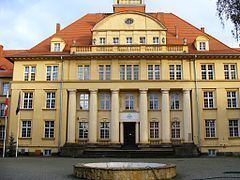Type Military School Completed 1914 Floors 4 | Country Poland Opened 1914 Construction started 1913 | |
 | ||
Classification N°601325-Reg.A/30/1-6, 28 December 2000 Location Gdańska street 190, Bydgoszcz, Poland Client German Army (German Empire) Architectural style Baroque Revival architecture Owner Ministry of National Defence Similar Theonia Reichhardt House in, Julius Grey house in Bydgoszcz, Alexander Timm House | ||
The War College building in Bydgoszcz is a historical building in Bydgoszcz, at Gdanska Street 190, property of Polish MOD. It is registered on the Kuyavian-Pomeranian Voivodeship Heriatge List.
Contents
Location
The building stands on the eastern side of Gdanska Street, in the area delimitated by:
This whole area lies within the Forest district in Bydgoszcz.
History
The building was built between 1913 and 1914 and designed by German architects Arnold Hartman and Robert Schlezinger.
The footprint of the project included in 1913 an area of approximately 22 hectares in the administrative boundaries of the city.
The estate was planned to be the seat of the German War College (German: Kriegschule), but the start of World War I changed it all, and the edifice housed during the conflict a German military hospital.
In 1920 the building was taken over by the Polish authorities of the city. After lengthy negotiations and efforts of General Kazimierz Sosnkowski, then Deputy Minister of Military Affairs, the city agreed to hand over the edifice to the Polish Ministry of Military Affairs.
In July 11, 1920 the building housed the High School of Infantry which had moved from Poznań due to the Polish–Soviet War.
On August 1, 1922 the school was converted into an Officer Academy for Non-Commissioned Officers (NCOs) and in August 9, 1928 it has been renamed the NCO Cadet School.
In the first half 1939, the building housed the Naval Cadet School.
From July 1, 1943 to January 17, 1945 the building, seized by Nazi armed forces, has accommodated the Intelligence and Cavalry School (German: Aufklärungs- und Kavallerieschule). After the liberation of Bydgoszcz in January 1945, Soviet troops were billeted here.
From 1947 to 2007, the edifice housed the Pomeranian Military District Command, and since 2007 it is the seat of the Inspectorate of Armed Forces Support.
In an adjacent building is open a military museum.
Architecture
The massive building has a "E-shaped" foot print, following eclecticism style with a clear predominance of neo-Baroque elements. The building has a prominent avant-corps on its center and wings: all is topped with high Mansard roofs with dormers.
The front portico, with Tuscan styled columns is prominent and topped by a balcony crowned with an elliptical pediment. The facade is divided by a series of decorative cornices and wide pilasters.
Among the noteworthy elements of architectural decoration and stucco are:
The interiors still preserve the original layout: adorned staircases, arcade hall, tiled corridors and walls with panelling and pilasters, and stucco ceilings.
Next to the War College is the former Directorate building (Polish: Willa Komendanta). It is an impressive villa with a portico, terraces, balconies and stylised pediments. The whole area is surrounded by a cast iron fence, decorated with stone trophies.
The building and its architectural environment has been put on the Kuyavian-Pomeranian Voivodeship heritage list (N°601325-Reg.A/30/1-6) on December 28, 2000.
